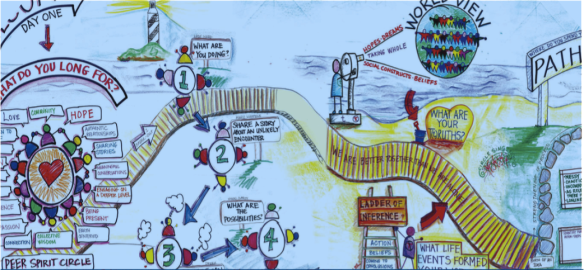In a recent conversation preparing for an upcoming Art of Hosting offering, the team talked about the challenge of describing what it is in a world that continues to look for clear deliverables and actions and when the language of AoH often seems theoretical or even fanciful. As a steward and practitioner who hosts all of my consulting work including the work Jerry Nagel and I do with Worldview Intelligence, this is a bone of contention. If the patterns and practices of AoH did not get results, we would not be using them. It’s as simple as that.
The discussion took us to what I often call the myths of Collaborative Leadership. One big myth is that collaborative leadership means no one is in charge. This is, in fact, not true. It does not mean no leadership. But it means leading in different ways and, for some people, that is both new and uncomfortable.
One of the things that AoH patterns and practices offers is structures for what the leadership can look like. Some quick highlights for the most used methods are below.
Circle practice shows us that there can be a leader in every chair, that leadership is shared, it rotates and everyone is collectively responsible for the well being of the group. It offers a way for all voices to come into the room and for groups to work through conflict, tension or the creative chaos that ensues when good ideas are flowing into a room.
World Café highlights the impact of making visible the collective intelligence in the room and using that information to move the needle on all kinds of issues, challenges and opportunities – including substantive issues like water quality, trauma, or impasses in an organization.
Open Space Technology brings to life the idea that people support that which they help to create, that we become deeply engaged in the issues and conversations we are passionate about and it provides an arena for conversations to come into a room, group or organization that might not otherwise have an avenue for discussion. In addition to generating new ideas and innovations, difficult and challenging conversations also find space in this process.
Leaders who are used to providing answers and direction to staff or others often do not know what they are supposed to do now. The default becomes to back off too much which then leaves people confused. People still need leadership, direction, clarity on what responsibility, authority and accountability they have. They need to know what the vision or future direction is that they are being asked to move toward, where there is room for change and what the parameters of the work are. Sometimes decisions need to be taken or given by people in formal leadership positions. And that is not only perfectly okay, it can be necessary depending on the circumstances. At a minimum decisions taken by the group need to be articulated.
Collaborative leadership is about the right leadership in the right moment by the right people. These people may just as readily be formal leaders as informal leaders. Collaborative leadership allows for greater possibility of both types of leadership and grows the cohesiveness, productivity and impact of any team or group who does this well.
This is one of the reasons why we continue to write about results in various projects and initiatives, which you can find under the category of Art of Hosting Works.










